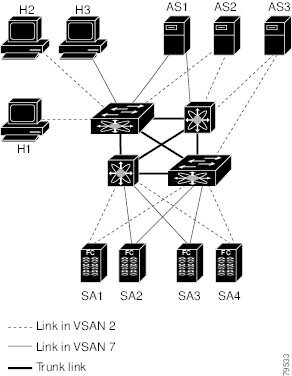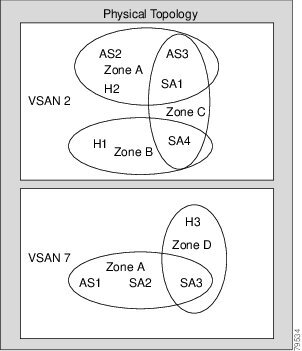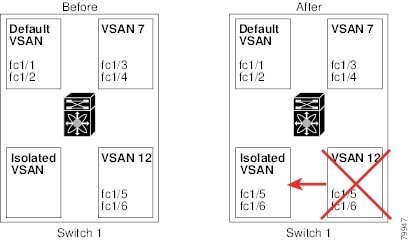

-
Cisco MDS 9000 Family Configuration Guide, Release 2.x
-
New and Changed Information
-
Index
-
Preface
- Part 1 - Getting Started
- Part 2 - Cisco MDS SAN-OS Installation and Switch Management
- Part 3 - Switch Configuration
-
Part 4 - Fabric Configuration
-
Configuring and Managing VSANs
-
Creating Dynamic VSANs
-
Configuring Inter-VSAN Routing
-
Configuring Zones
-
Distributing Device Alias Services
-
Configuring Fibre Channel Routing Services and Protocols
-
Managing FLOGI, Name Server, FDMI, and RSCN Databases
-
Discovering SCSI Targets
-
Configuring FICON
-
Advanced Features and Concepts
-
- Part 5 - Security
- Part 6 - IP Services
- Part 7 - Intelligent Storage Services
- Part 8 - Network and Switch Monitoring
- Part 9 - Traffic Management
- Part 10 - Troubleshooting
-
Table Of Contents
Configuring and Managing VSANs
Displaying Isolated VSAN Membership
Creating and Configuring VSANs Statically
Assigning Static Port VSAN Membership
Displaying Static VSAN Configurations
Configuring and Managing VSANs
You can achieve higher security and greater stability in Fibre Channel fabrics by using virtual SANs (VSANs). VSANs provide isolation among devices that are physically connected to the same fabric. With VSANs you can create multiple logical SANs over a common physical infrastructure. Each VSAN can contain up to 239 switches and has an independent address space that allows identical Fibre Channel IDs (FCIDs) to be used simultaneously in different VSANs. This chapter includes the following sections:
•
Creating and Configuring VSANs Statically
About VSANs
A VSAN is a virtual storage area network (SAN). A SAN is a dedicated network that interconnects hosts and storage devices primarily to exchange SCSI traffic. In SANs you use the physical links to make these interconnections. A set of protocols run over the SAN to handle routing, naming, and zoning. You can design multiple SANs with different topologies.
VSAN Topologies
With the introduction of VSANs, the network administrator can build a single topology containing switches, links, and one or more VSANs. Each VSAN in this topology has the same behavior and property of a SAN. A VSAN has the following additional features:
•
Multiple VSANs can share the same physical topology.
•
The same Fibre Channel IDs (FC IDs) can be assigned to a host in another VSAN, thus increasing VSAN scalability.
•
Every instance of a VSAN runs all required protocols such as FSPF, domain manager, and zoning.
•
Fabric-related configurations in one VSAN do not affect the associated traffic in another VSAN.
•
Events causing traffic disruptions in one VSAN are contained within that VSAN and are not propagated to other VSANs.
The switch icons shown in both Figure 20-1 and Figure 20-2 indicate that these features apply to any switch in the Cisco MDS 9000 Family.
Figure 16-1 shows a fabric with three switches, one on each floor. The geographic location of the switches and the attached devices is independent of their segmentation into logical VSANs. No communication between VSANs is possible. Within each VSAN, all members can talk to one another.
Figure 16-1 Logical VSAN Segmentation
Figure 16-2 shows a physical Fibre Channel switching infrastructure with two defined VSANs: VSAN 2 (dashed) and VSAN 7 (solid). VSAN 2 includes hosts H1 and H2, application servers AS2 and AS3, and storage arrays SA1 and SA4. VSAN 7 connects H3, AS1, SA2, and SA3.
Figure 16-2 Example of two VSANs
The four switches in this network are interconnected by trunk links that carry both VSAN 2 and VSAN 7 traffic. Thus the inter-switch topology of both VSAN 2 and VSAN 7 are identical. This is not a requirement and a network administrator can enable certain VSANs on certain links to create different VSAN topologies.
Without VSANs, a network administrator would need separate switches and links for separate SANs. By enabling VSANs, the same switches and links may be shared by multiple VSANs. VSANs allow SANs to be built on port granularity instead of switch granularity. Figure 20-2 illustrates that a VSAN is a group of hosts or storage devices that communicate with each other using a virtual topology defined on the physical SAN.
The criteria for creating such groups differ based on the VSAN topology:
•
VSANs can separate traffic based on the following requirements:
–
Different customers in storage provider data centers
–
Production or test in an enterprise network
–
Low and high security requirements
–
Backup traffic on separate VSANs
–
Replicating data from user traffic
•
VSANs can meet the needs of a particular department or application.
VSAN Advantages
VSANs offer the following advantages:
•
Traffic isolation—Traffic is contained within VSAN boundaries and devices reside only in one VSAN ensuring absolute separation between user groups, if desired.
•
Scalability—VSANs are overlaid on top of a single physical fabric. The ability to create several logical VSAN layers increases the scalability of the SAN.
•
Per VSAN fabric services—Replication of fabric services on a per VSAN basis provides increased scalability and availability.
•
Redundancy—Several VSANs created on the same physical SAN ensure redundancy. If one VSAN fails, redundant protection (to another VSAN in the same physical SAN) is configured using a backup path between the host and the device.
•
Ease of configuration—Users can be added, moved, or changed between VSANs without changing the physical structure of a SAN. Moving a device from one VSAN to another only requires configuration at the port level, not at a physical level.
Up to 256 VSANs can be configured in a switch. Of these, one is a default VSAN (VSAN 1), and another is an isolated VSAN (VSAN 4094). User-specified VSAN IDs range from 2 to 4093.
How VSANs Work
A VSAN is a virtual storage area network (SAN). A SAN is a dedicated network that interconnects hosts and storage devices primarily to exchange SCSI traffic. In SANs you use the physical links to make these interconnections. A set of protocols run over the SAN to handle routing, naming, and zoning. You can design multiple SANs with different topologies.
With the introduction of VSANs, the network administrator can build a single topology containing switches, links, and one or more VSANs. Each VSAN in this topology has the same behavior and property of a SAN. A VSAN has the following additional features:
•
Multiple VSANs can share the same physical topology.
•
The same Fibre Channel IDs (FCIDs) can be assigned to a host in another VSAN, thus increasing VSAN scalability.
•
Every instance of a VSAN runs all required protocols such as FSPF, domain manager, and zoning.
•
Fabric-related configurations in one VSAN do not affect the associated traffic in another VSAN.
•
Events causing traffic disruptions in one VSAN are contained within that VSAN and are not propagated to other VSANs.
As displayed in both Figure 16-3 and Figure 16-4, the switch icons indicate that these features apply to any switch in the Cisco MDS 9000 Family.
Figure 16-3 shows a fabric with three switches, one on each floor. The geographic location of the switches and the attached devices is independent of their segmentation into logical VSANs. Between VSANs no communication is possible. Within each VSAN, all members can talk to one another.
Figure 16-3 Logical VSAN Segmentation
Figure 16-4 shows a physical Fibre Channel switching infrastructure with two defined VSANs: VSAN 2 (dashed) and VSAN 7 (solid). VSAN 2 includes hosts H1 and H2, application servers AS2 and AS3, and storage arrays SA1 and SA4. VSAN 7 connects H3, AS1, SA2, and SA3.
Figure 16-4 Example of two VSANs
The four switches in this network are interconnected by trunk links that carry both VSAN 2 and
VSAN 7 traffic. Thus the inter-switch topology of both VSAN 2 and VSAN 7 are identical. This is not a requirement and a network administrator can enable certain VSANs on certain links to create different VSAN topologies.Without VSANs, a network administrator would need separate switches and links for separate SANs. By enabling VSANs, the same switches and links may be shared by multiple VSANs. VSANs allow SANs to be built on port granularity instead of switch granularity. Figure 16-4 illustrates that a VSAN is a group of hosts or storage devices that communicate with each other using a virtual topology defined on the physical SAN.
The criteria for creating such groups differ based on the VSAN topology:
•
VSANs can separate traffic based on the following requirements:
–
Different customers in storage provider data centers
–
Production or test in an enterprise network
–
Low and high security requirements
–
Backup traffic on separate VSANs
–
Replicating data from user traffic
•
VSANs can meet the needs of a particular department or application.
VSANs Versus Zones
You can define multiple zones in a VSAN. Because two VSANs are equivalent to two unconnected SANs, zone A on VSAN 1 is different and separate from zone A in VSAN 2. Table 16-1 lists the differences between VSANs and zones.
Figure 16-5 shows the possible relationships between VSANs and zones. In VSAN 2, three zones are defined: zone A, zone B, and zone C. Zone C overlaps both zone A and zone B as permitted by Fibre Channel standards. In VSAN 7, two zones are defined: zone A and zone D. No zone crosses the VSAN boundary—they are completely contained within the VSAN. Zone A defined in VSAN 2 is different and separate from zone A defined in VSAN 7.
Figure 16-5 VSANS with Zoning
Default and Isolated VSANs
Up to 256 VSANs can be configured in a switch. Of these, one is a default VSAN (VSAN 1), and another is an isolated VSAN (VSAN 4094). User-specified VSAN IDs range from 2 to 4093.
Default VSAN
The factory settings for switches in the Cisco MDS 9000 Family have only the default VSAN 1 enabled. If you do not need more than one VSAN for a switch, use this default VSAN as the implicit parameter during configuration. If no VSANs are configured, all devices in the fabric are considered part of the default VSAN. By default, all ports are assigned to the default VSAN.
Note
VSAN 1 cannot be deleted, but it can be suspended.
Isolated VSAN
VSAN 4094 is an isolated VSAN. All non-trunking ports are transferred to this VSAN when the VSAN to which they belong is deleted. This avoids an implicit transfer of ports to the default VSAN or to another configured VSAN. All ports in the deleted VSAN are isolated (disabled).
Note
When you configure a port in VSAN 4094 or move a port to VSAN 4094, that port is immediately isolated.
CautionDo not use an isolated VSAN to configure ports.
Displaying Isolated VSAN Membership
The show vsan 4094 membership command displays all ports associated with the isolated VSAN.
VSAN Attributes
VSANs have the following attributes:
•
VSAN ID—The VSAN ID identifies the VSAN as the default VSAN (VSAN 1), user-defined VSANs (VSAN 2 to 4093), and the isolated VSAN (VSAN 4094).
•
State—The administrative state of a VSAN can be configured to an active (default) or suspended state. Once VSANs are created, they may exist in various conditions or states.
–
The active state of a VSAN indicates that the VSAN is configured and enabled. By enabling a VSAN, you activate the services for that VSAN.
–
The suspended state of a VSAN indicates that the VSAN is configured but not enabled. If a port is configured in this VSAN, it is disabled. Use this state to deactivate a VSAN without losing the VSAN's configuration. All ports in a suspended VSAN are disabled. By suspending a VSAN, you can preconfigure all the VSAN parameters for the whole fabric and activate the VSAN immediately.
•
VSAN name—This text string identifies the VSAN for management purposes. The name can be from 1 to 32 characters long and it must be unique across all VSANs. By default, the VSAN name is a concatenation of VSAN and a four-digit string representing the VSAN ID. For example, the default name for VSAN 3 is VSAN0003.
Note
A VSAN name must be unique.
•
Load balancing attributes—These attributes indicate the use of the source-destination ID (src-dst-id) or the originator exchange OX ID (src-dst-ox-id, the default) for load balancing path selection.
Note
OX ID based load balancing of IVR traffic from IVR- enabled switches is not supported on Generation 1 switching modules. OX ID based load balancing of IVR traffic from a non-IVR MDS switch should work. Generation 2 switching modules support OX ID based load balancing of IVR traffic from IVR-enabled switches.
Operational State of a VSAN
A VSAN is in the operational state if the VSAN is active and at least one port is up. This state indicates that traffic can pass through this VSAN. This state cannot be configured.
VSAN Membership
Port VSAN membership on the switch is assigned on a port-by-port basis. By default each port belongs to the default VSAN. You can assign VSAN membership to ports using one of two methods:
•
Statically—by assigning VSANs to ports.
For information about changing VSAN membership, see the "Creating and Configuring VSANs Statically" section.
•
Dynamically—by assigning VSANs based on the device WWN. This method is referred to as the Dynamic Port VSAN Membership (DPVM) feature.
See Chapter 17, "Creating Dynamic VSANs.".
Trunking ports have an associated list of VSANs that are part of an allowed list (see Chapter 12, "Configuring Trunking").
Creating and Configuring VSANs Statically
You cannot configure any application-specific parameters for a VSAN before creating the VSAN.
To create and configure VSANs, follow these steps:
Assigning Static Port VSAN Membership
To statically assign VSAN membership for an interface, follow these steps:
Deleting Static VSANs
When an active VSAN is deleted, all of its attributes are removed from the running configuration. VSAN-related information is maintained by the system software as follows:
•
VSAN attributes and port membership details are maintained by the VSAN manager. This feature is affected when you delete a VSAN from the configuration. When a VSAN is deleted all the ports in that VSAN are made inactive and the ports are moved to the isolated VSAN. If the same VSAN is recreated, the ports do not automatically get assigned to that VSAN. You must explicitly reconfigure the port VSAN membership (see Figure 16-6).
Figure 16-6 VSAN Port Membership Details
•
VSAN-based runtime (name server), zoning, and configuration (static routes) information is removed when the VSAN is deleted.
•
Configured VSAN interface information is removed when the VSAN is deleted.
Note
The allowed VSAN list is not affected when a VSAN is deleted (see Chapter 12, "Configuring Trunking").
Any commands for a nonconfigured VSAN are rejected. For example, if VSAN 10 is not configured in the system, then a command request to move a port to VSAN 10 is rejected.
To delete a VSAN and its various attributes, follow these steps:
Displaying Static VSAN Configurations
Use the show vsan command to display information about configured VSANs (see Examples 16-1 to 16-6).
Example 16-1 Displays the Configuration for a Specific VSAN
switch# show vsan 100vsan 100 informationname:VSAN0100 state:activein-order guarantee:no interoperability mode:noloadbalancing:src-id/dst-id/oxidExample 16-2 Displays the VSAN Usage
switch# show vsan usage4 vsan configuredconfigured vsans:1-4vsans available for configuration:5-4093Example 16-3 Displays All VSANs
switch# show vsanvsan 1 informationname:VSAN0001 state:activein-order guarantee:no interoperability mode:noloadbalancing:src-id/dst-id/oxidvsan 2 informationname:VSAN0002 state:activein-order guarantee:no interoperability mode:noloadbalancing:src-id/dst-id/oxidvsan 7 informationname:VSAN0007 state:activein-order guarantee:no interoperability mode:noloadbalancing:src-id/dst-id/oxidvsan 100 informationname:VSAN0100 state:activein-order guarantee:no interoperability mode:noloadbalancing:src-id/dst-id/oxidvsan 4094:isolated vsanExample 16-4 Displays Membership Information for the Specified VSAN
switch # show vsan 1 membershipvsan 1 interfaces:fc1/1 fc1/2 fc1/3 fc1/4 fc1/5 fc1/6 fc1/7 fc1/9fc1/10 fc1/11 fc1/12 fc1/13 fc1/14 fc1/15 fc1/16 port-channel 99
Note
Interface information is not displayed if interfaces are not configured on this VSAN.
Example 16-5 Displays Static Membership Information for All VSANs
switch # show vsan membershipvsan 1 interfaces:fc2/16 fc2/15 fc2/14 fc2/13 fc2/12 fc2/11 fc2/10 fc2/9fc2/8 fc2/7 fc2/6 fc2/5 fc2/4 fc2/3 fc2/2 fc2/1fc1/16 fc1/15 fc1/14 fc1/13 fc1/12 fc1/11 fc1/10 fc1/9fc1/7 fc1/6 fc1/5 fc1/4 fc1/3 fc1/2 fc1/1vsan 2 interfaces:vsan 7 interfaces:fc1/8vsan 100 interfaces:vsan 4094(isolated vsan) interfaces:Example 16-6 Displays Static Membership Information for a Specified Interface
switch # show vsan membership interface fc1/1fc1/1vsan:1allowed list:1-4093Default Settings
Table 16-2 lists the default settings for all configured VSANs.

 Feedback
Feedback




